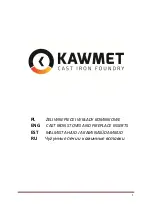
20
Encore
®
2040CE Non-Catalytic / Catalytic Wood Burning Stove
30005552
6. Starting at one end, press the gasket into the channel.
(Fig. 35) Ensure a good joint where the gasket meets before
trimming any excess. Do not overlap the gasket ends or
leave ends with ragged edges.
7. Press the gasketed part fi rmly against its normal mating
surface to seat the gasket evenly in its channel. Close and
latch the door to do this, or tap other parts with the rubber
mallet (or hammer/block of wood).
8. Clean any excess cement from around the channel, then
let the cement that holds the new gasket dry thoroughly.
9. The stove’s doors may need adjustment after you have
regasketed them. Initially, it may require loosening the
latch to accommodate the new gasket; after a few weeks,
it may need tightening to compensate for compression of
the new gasket. The directions for adjusting the latches
are on Page 19.
Fig. 34
Remove gasket then clean channel with wire brush.
ST560
Cement
Sto
ve Gasket
ST561
Fig. 35
Lay a bead of gasket silicone or cement then press
gasket in place.
3. Determine the correct length of the appropriate-sized
gasket by laying it out in the channel. Allow an extra 1-2”
(25-50 mm), and mark the spot to be cut.
4. Remove the gasket from the channel, place it on a
wood cutting surface, and cut it at the marked spot with a
utility knife.
Twist the ends slightly to keep the gasket from unravel-
ing.
5. Lay an unbroken 1/8” (3 mm) bead of silicone or cement
in the newly-cleaned channel. (Fig. 35)
All Gasketed Construction Gaskets
Other gaskets form seals between all other non-moving
parts, but these are not subject to the same wear and
deterioration as gaskets on moving parts. It is unlikely
that you will ever need to replace these gaskets unless
the involved parts are disassembled and then put back
together. If this is the case, the job should be done only
by a qualifi ed service technician.
5/16” diameter gasket seals the following parts:
•
The lower fi reback to the back panel
•
The left and right air plates (inner sides)
•
All connections between the stove plates.
The Chimney System
Creosote
Your Encore is designed to reduce creosote build-up
signifi cantly. However, regular chimney inspection and
maintenance must still be performed. For safety, good stove
performance, and to protect your chimney and chimney
connector, inspect your chimney and chimney connector
on a regular schedule. Clean the system if necessary.
Failure to keep the chimney and connector system clean
can result in a serious chimney fi re.
When wood is burned slowly, it produces tar, organic vapors
and moisture that combine to form creosote. The creosote
vapors condense in the relatively cool chimney fl ue of a
slow-burning fi re. As a result, creosote residue accumulates
on the fl ue lining. When ignited, this creosote makes an
extremely hot fi re within the fl ue system that can damage
the chimney and overheat adjacent combustible material.
If a signifi cant layer of creosote has accumulated —1/8”
(3 mm) or more — it should be removed to reduce the risk
of a chimney fi re.
You can never be too safe. Contact your local fi re author-
ity for information on what to do in the event of a chimney
fi re, and have a clearly understood plan on how to handle
one.
If you do experience a chimney fi re, act promptly to:
• Close the damper and air control lever.
• Get everyone out of the house.
• Call the Fire Department.
Inspect the system every two weeks during the heating
season as part of a regular maintenance schedule. To
inspect the chimney, let the stove cool completely. Then,
using a mirror and a strong light, sight up through the fl ue
collar into the chimney fl ue. If you cannot inspect the fl ue
system in this fashion, the stove must be disconnected to
provide better viewing access.











































